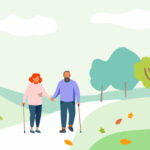My home state of New Jersey has, largely, gotten back to normal, relaxing initial stay-at-home orders from earlier this year. Businesses are open (though many at reduced capacity), and we come and go in public. But does it feel normal? Many still fret about COVID-19 safety, both at home and around town.
Germs skeeved me out as it was, but this pandemic has made me extra vigilant of everything I might touch. I remember during early restrictions that I planned out how to maneuver myself in a store, at the cash registers, etc. From this, my COVID-19 Safety Kit was born!

COVID-19 SAFETY TOOL #1: Hand Sanitizer
Let’s get the obvious ones out of the way first. At home, I have pumps in each bathroom and the kitchen (which is right off my entryway), but I noticed I wasn’t using them as much as I thought. Since washing with soap and water is better, I tend to use that method while at home.
However, during essential trips to the store, the gas station and Dairy Queen (frozen treats are a necessity, right?), it is a MUST that I keep pocket sanitizer with me at all times. I keep one in the car and one in my purse. I use it to spray cart or basket handles; when I get to the register I use it before passing any money to the cashier; when I get to the car I use it again on my hands and steering wheel, and then wash well with soap and water when I arrive home. I even spray my credit cards when handed back to me (which likely may ruin the magnetic strip, but I’ll cross that bridge when I come to it).
My colleague, and fellow author Stephanie Eisele, also keeps disinfectant wipes on her when shopping; something I should probably add to my tackle.

COVID-19 SAFETY TOOL #2: Face Masks
Also an obvious one, and mandated in many cases, is face masks. Facial coverings are constructed differently, so it’s important you find a type that is best for you… so you stick with it. I’d like to direct your attention to a previous article that compares the best face masks for more information on this safety tool.
The CDC recommends that masks have 2 or more layers of washable, breathable fabric.

COVID-19 SAFETY TOOL #3: Touch Tool
My. Ultimate. Favorite!
What does it do? It touches things so you don’t have to… keypads, elevators, touch screens. Mine also pulls door handles and pops bottle caps. Fasten it to a retractable cord, like me, and hook to your belt loop or purse handle for quick access when out on the town (warning: you may get hit on for being so super cool). Mine is made of brass, a copper alloy alleged to be antimicrobial.

COVID-19 SAFETY TOOL #4: UVC Lamps & Wands
Second favorite!
My father, a battery and lighting expert, swears by this these lights. Ultraviolet light (subtype C) can damage viruses and bacteria so they don’t replicate, particularly on hard surfaces. Dad used room lamps, similar to what many hospitals are using, to disinfect rooms of the house we rented this summer hours before the rest of the family arrived. I take a portable UVC wand with me for any necessary stops at a public restroom. I turn it on and wave the wand slowly – for at least 5 passes – over contaminated surfaces like the door handle, toilet seat, paper dispenser, sink knobs, etc. Yes, people look at me cockeyed, and yes, it takes me longer get in and out, but I truly feel more protected.

COVID-19 SAFETY TOOL #5: Pen
Basic, I know, but how many times have you been at the checkout counter and asked to sign a receipt? Or sign in for an appointment? I never use the available pen, touched by dozens before me. And honestly, I never trust when they say they’ve been sanitized. Just bring one from home in your purse, pocket or fanny pack.
Some of you may be thinking, “What about disposable gloves?” I think the jury is still out on that one. Some say that wearing gloves serves as a reminder to not touch your face. In fact, I started out using gloves in the grocery store that first weekend before the stay-at-home order was in effect. But then I heard that doing so spreads germs from one object to another, so in the spirit of public safety I decided against it. The CDC recommends wearing gloves only when cleaning and/or caring for the sick.1
Of course none of the above strategies are in isolation. I also continue to distance myself physically from others when in public, don’t mingle in large crowds unnecessarily, wash hands often with soap and water, change clothes/shoes when I arrive home, and stay in if feeling less than stellar. But whether it’s truly effective or simply peace of mind, my COVID-19 safety kit is with me at all times.
1 The Centers for Disease Control, “When to Wear Gloves”














